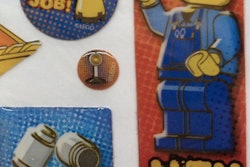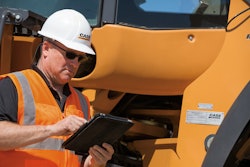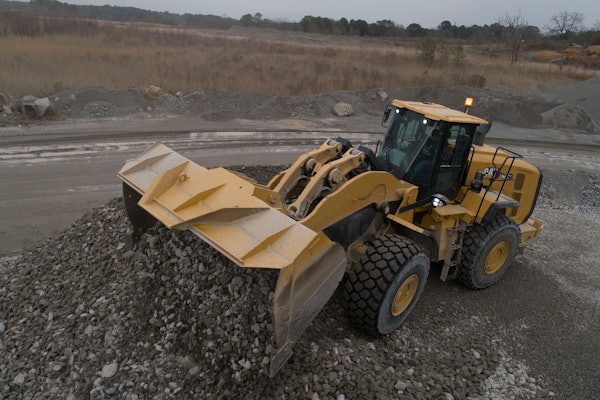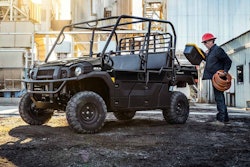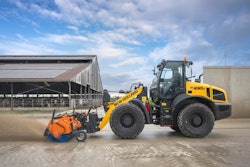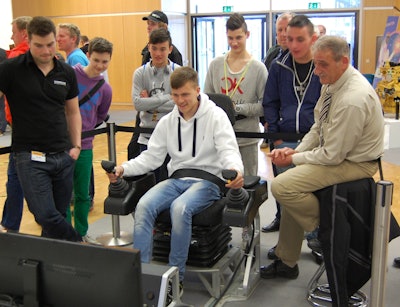 More fun than a video game. Teens at Think Big were encouraged to try their hand and equipment simulators.
More fun than a video game. Teens at Think Big were encouraged to try their hand and equipment simulators.Contractors and equipment dealers struggling to find a solution to the shortage of trained technicians in the United States, need look no further than Germany for an example of how to do it right.
The German Engineering Federation, VDMA, last month bussed in more than 10,000 teens to participate in Bauma 2013 and a program they called Think Big. (Bauma is the big construction equipment show for Europe, held every three years in Munich.) There, the teens got an up close look at the kind of careers they might undertake if they liked what they saw.
“The image some people have of this work is that it is dirty, loud and ugly, all negative. We wanted to change that.”
Bauma officials also dedicated an entire exhibition hall to Think Big. Here the teens could play with simulators, computer animations, engine diagnostic tools and video games designed to show them what it’s like to work with today’s high-tech construction equipment. In addition to the hands-on stations, static displays of heavy equipment filled one-side of the hall, and employees from Caterpillar, Volvo, Wacker-Neuson and other OEMs gave presentations about their machines and job prospects for future technicians.
While at Bauma I spoke with Ann-Marei Zwickirsch and Uta Kiefer who work for the VDMA and helped organize the Think Big event. Their typical attendee was 15 years old, Zwickirsch said, and in 9th or 10th grade. There were also a handful of older students present, one at each station, who are already in equipment-related vocational programs. The older students helped walk the younger kids through the interactive exhibits and answered questions about what life was like in their respective vocational career tracks.
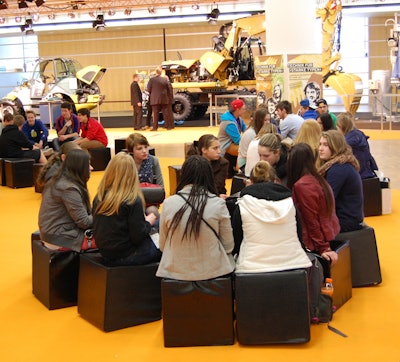 The Think Big hall at Bauma had plenty of room for static displays as well as gathering spaces, refreshments and techno-music to keep the atmosphere lively.
The Think Big hall at Bauma had plenty of room for static displays as well as gathering spaces, refreshments and techno-music to keep the atmosphere lively.“Previously we brought kids to Bauma, but only for guided tours,” Kiefer said, “but this year we wanted to do something new. We hope to convince them not to be afraid of it, especially the girls. We have a 50/50 ratio of boys to girls. The image some people have of this work is that it is dirty, loud and ugly, all negative. We wanted to change that. It’s much more high tech. They use laptops, and the scope of the job has changed, but not many people know it.”
The VDMA’s goals in putting together the Think Big program was not to directly recruit kids into the industry, but to change perceptions. “This is just the first step in the right direction,” Zwickirsch said. “It’s important for us that they have these possibilities in mind. Society needs to think more about these things.”
Would a program like Think Big work in the U.S.? Yes, but the details, execution and support would need to change to fit our unique environment. The VDMA is a big organization serving a relatively small country. It represents almost all the technical and industrial interests of Germany. Construction machinery and building technology firms are just two of the 39 categories it serves. It has more than 3,000 German and international member companies.
 Computer games impressed upon the teens the high-tech nature of the equipment business.
Computer games impressed upon the teens the high-tech nature of the equipment business.Here in the U.S., we have many small associations trying to serve the needs of a big country.
Another difference that makes vocational education a harder sell in the United States is that the German public has a more positive opinion of the trades than most Americans. Half of all German high school students are routed into vocational education programs, starting at age 16. Technical proficiency is a matter of national pride and economic strength. German Chancellor Angela Merkel said recently when asked why Germany was doing better than any of the other Euro-nation states: “We still make things here.”
“The question is, how do we turn this around?”
In the United States, the education establishment puts most of it’s eggs in the college basket. Our vocational and technical schools are starved for funding. Fewer than one percent of our high school students go into vocational apprenticeships. In terms of the work-readiness of high-school graduates, the United States ranks dead last out of 29 countries studied.
Yet for all the money we spend on colleges and universities almost half the students that start at a four-year college fail to obtain a degree. We have the highest college dropout rates in the industrialized world. Of those who do graduate, half are working in jobs that don’t require a degree.
This leaves us with a dire shortage of skilled tradespeople and a surplus of over-educated young people working in low-wage, low-skill jobs. The end result is that we have both high unemployment and 3.5 million job vacancies.
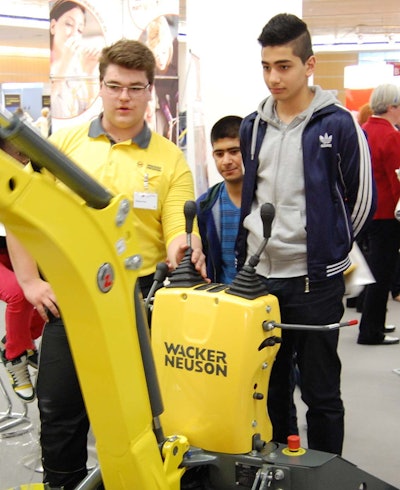 Older students already in a vocational track were on hand to answer questions and help the younger ones understand the work they’d be doing.
Older students already in a vocational track were on hand to answer questions and help the younger ones understand the work they’d be doing.These are big problems, and the construction trades and equipment industry are just two of the business sectors that suffer from them. The question is, how do we turn this around?
A first step toward replicating the kind of success Germany has with vocational training would be for the construction associations to come together with other industrial and manufacturing interests and form an umbrella group with the kind of clout VDMA has. The Association of Equipment Manufacturers, the Associated General Contractors, the Associated Equipment Distributors and the dozens of other industry associations do good work, but on the national scene they are, separately, very small fish in a big pond, all but invisible in state and national politics.
Second, our manufacturers, large construction companies and related associations ought to think seriously about putting together a traveling exhibit of some kind that could generate the kind of fun and appeal that Think Big created for German kids at Bauma.
And finally the United States as a society needs to, as Ms. Zwickirsch said, “think more about these things.” Our inability to match our educational programs to the needs of society is creating a drag on our economy and wasting the talents and energy of generations of young people.
It’s not like we don’t have a policy. Our policy is to do nothing. And last I checked, Americans don’t consider themselves a do-nothing people. But here we are.
It is curious that the Germans are using an American expression, “Think Big” to motivate their future technicians. We’re certainly not thinking big enough in this country, and it’s time that changed.




